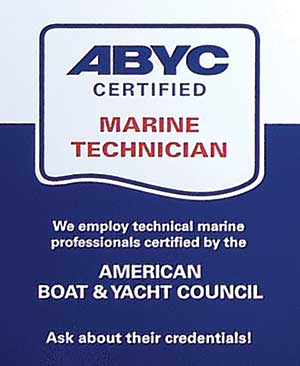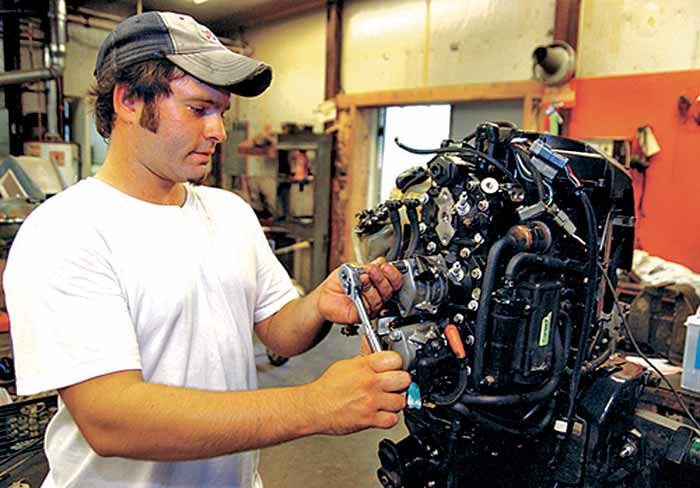Advertisement
"Don't worry about it!" means you should probably worry about it.

You shouldn't trust a complex repair job to just any shop. (Photo: Billy Black)
For over 25 years, BoatUS has been helping our Members resolve disputes with repair facilities; in fact, that's one of our most common complaints. But helping to resolve complaints isn't all we do. Our goal is to help you avoid having a dispute in the first place. After handling problems for thousands of Members over the years, we've come up with eight tips that can help you stay on an even keel when dealing with a repair facility.
1. Selecting A Repair Shop

Before choosing a facility, ask for referrals from fellow boaters or someone you trust in the marine business. Also, conduct an Internet search for online reviews, visit boat-owner forums to learn what your neighbors think, and look for complaints with the Better Business Bureau. Finally, check with us at BoatUS to see if Members have filed compliments or complaints about a particular company. Keep in mind that while their rates may be higher, shop owners who invest in good diagnostic equipment and in technicians certified both by manufacturers and by the American Boat & Yacht Council typically offer better service.
2. Get It In Writing!
As the old legal saying puts it, if it's not in writing, it didn't happen. Verbal agreements are often misunderstood, so a written agreement can save you a big headache later. Once you've chosen a shop, obtain a written estimate of the time it will take to complete the repairs and the amount it will likely cost. Don't forget to ask if storage fees will be charged once the repair has been completed. Even if you have a long-term relationship with a shop, don't skip these steps. It's a business, so treat it that way. If having your old parts returned to you is important (as it will be if you have to file an insurance claim), write that into the estimate as well. If money is tight, include a "not to exceed unless called" dollar amount. Remember that because boat (and engine) repairs can be complicated, unforeseen obstacles can crop up during the repair. Ask the shop what similar repairs have cost and what kinds of problems are possible. Make sure you're very clear on what the shop's labor rates are and when they're charged; many shops start charging when workers leave the shop, not when they arrive at your boat.
3. Is There A Warranty?
You need to know if your repair will be covered by a warranty. Don't assume. Usually shops offer a 30-, 60-, or 90-day warranty on their work. If so, ask if it covers parts and labor. "Don't worry about it" is not a warranty. If a shop's warranty policy isn't stated in writing, ask for the coverage to be written into your repair estimate. Most shops won't include service calls to your boat should the boat break down while under warranty, but ask; if it's close by, they might. One thing that will almost certainly invalidate your warranty is if, out of frustration, you have another shop try to fix the problem. Warranty law generally allows a shop a reasonable number of attempts to correct its own work.
Advertisement
4. Remove Valuable Items
Many BoatUS Members have asked us over the years to help them get a repair shop to reimburse them for items they say went missing from their boat while it was in the shop's care. Unfortunately, without proof, such as a dated picture of the items on the boat with the shop shown in the picture, you'll face an uphill battle. It's best to remove valuable items (especially small electronics, personal items, and fishing gear) from your boat before bringing it to the shop.
5. A Picture Is Worth $1,000
Take a few pictures of your boat from all sides while it's sitting at the shop. Then, if a big scratch appears that wasn't there before, you'll have a picture to prove it. Take more pictures inside if that's where the work is to be done. It's a lot easier to get a shop to fix a stained seat or ripped canvas if you have proof that the damage wasn't there before. Check the boat again before bringing it home, and point out problem areas before you pay. If the shop says it will take care of it, get that in writing. Make sure all your photos are time stamped, and take more pictures than you think you need.
6. Don't Let It Languish
Sometimes we get complaints from a Member that begin, "A few months ago, I brought my boat to XYZ Repair, and they haven't even started on it yet." Bringing your boat in for repair and not checking on it for three months is a bad idea. Never tell repairmen that you're in no hurry and that they can work on it when they get around to it. You risk being pushed to the back burner. Even if you aren't in a rush, don't let the boat languish. The longer it sits at a shop, the more likely it can get damaged or have parts "borrowed" from it. Just as important, inquire frequently about ongoing repairs. While there are often legitimate delays due to parts sourcing, weather, and personnel issues, if you think you're being put off, you probably are. It's often better to cut your losses and go to another shop than hope for the best. If you can't get to the shop and have no one that can check on it for you, ask the shop to send you pictures of the work in progress; that may motivate the workers.
7. Inspect Repairs And Invoices
When the shop calls and says your boat is ready to be picked up, look carefully over both your bill and your boat. If everything has gone per plan, there should be no surprises. If there's a disputed charge and the shop refuses to help you, note it on the invoice, but pay your bill in full — by credit card, if possible. If you don't pay the bill in full, the shop can obtain a lien on your boat even if the repair is faulty. You'll be in a much stronger position to work out problems if you pay the bill by credit card and dispute it later. Next, make sure you sea-trial your boat within the warranty period. If there are problems, it's important to find and report them right away; the shop's warranty starts as soon as you pay for the work. Members who have work done at the end of the boating season and put their boat away before testing the repairs can get a nasty surprise in the spring when they discover that the repairs are faulty and that the warranty is up.

A written estimate detailing the scope of work required to make a repair can reveal extra costs due to access issues.
8. When Something Goes Wrong
Most of the time, a shop will work with you if there's a problem; after all, they want return business. But if there's a faulty repair that the shop can't or won't fix, you may have to call in a third-party expert, such as a certified mechanic or surveyor. If the shop refuses to cooperate regarding a disputed charge or repair, send a written complaint to the shop, and keep all invoices and correspondence to document your complaint. If you paid by credit card, you can get the credit-card company involved by disputing the charge. While we help resolve many complaints every year and often have considerable influence, we don't have legal authority to compel a shop to cooperate; in the end, you may have to resort to small-claims court. Again, not paying the bill isn't really an option because it can result in a lien being placed on your boat, and you don't need that hassle while trying to work out a solution. Good service or bad, you'll need to pay the bill first, then prove that it's unfair. One more thing: Don't take to the Internet to bash the shop; that's guaranteed to stop whatever communication you had and will make it much harder to find a solution.
The good news is that the vast majority of shops are in business for the long run and will usually work hard to resolve problems. Having these few hard-won tips in your back pocket can help you avoid potential shoals and keep you where you want to be — on the water.
